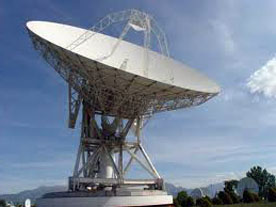SATCOM Post-2000 (Archived)
The NATO SATCOM Post-2000 (NSP2K) programme gave the Alliance from 2005 until 2019 improved satellite communication capabilities, which was important as NATO forces took on expeditionary missions far beyond the Alliance’s traditional area of operations. As of January 2020, the NSP2K programme was succeeded by a new satellite services project called NATO SATCOM Services 6th Generation, or NSS6G.

Under the programme, a consortium formed by the British, French and Italian governments provided NATO with advanced satellite communication (SATCOM) capabilities for a 15-year period from January 2005 until the end of 2019.
The satellite capacity was provided on the three nations’ satellites under a capability provision agreement which had the flexibility to be changed depending on evolving operational requirements. Compared to previous generation SATCOM capabilities, the programme benefits included increased bandwidth, coverage and expanded capacity for voice and data communications, including communications with ships at sea, air assets and troops deployed across the globe.
Components
Under a memorandum of understanding, the NSP2K programme provided NATO with access to the military segments of three national satellite communications systems – the French SYRACUSE 3, the Italian SICRAL 1 and 1Bis and the British Skynet 4 and 5.
This satellite capability replaced the two NATO-owned and -operated NATO IV communications satellites, which stopped their operational services in 2007 and 2010, respectively, after a combined operational life of 19 years.
The programme provided NATO access to super high frequency (SHF) and ultra-high frequency (UHF) communications. UHF (300 MHz) is used for tactical communications, while SHF (7-8 GHz) is used for static and deployed ground stations with larger antenna dishes.
The SYRACUSE, SICRAL and Skynet 4/5 satellites can all provide SHF communications with military hardening features, while UHF communications are only provided by the SICRAL and Skynet satellites.
Contract evolution
In May 2004, the NATO Consultation, Command and Control Agency (NC3A), now known as the NATO Communications and Information (NCI) Agency, selected the Franco-British-Italian proposal to provide SHF and UHF communications.
The proposal submitted by the consortium was determined by NATO to be the lowest priced, technically compliant bid. It came in below the Alliance’s funding ceiling of EUR 457 million for SHF and UHF.
The NSP2K Initial Operational Capability started in January 2005 with limited SHF and UHF capacity and coverage, which was followed by Final Operational Capability as of 2008 with the full SHF and UHF capacity and extended coverage.
As of January 2020, the NSP2K programme was succeeded by a new satellite services project called NATO SATCOM Services 6th Generation (NSS6G).
Mechanisms
The NSP2K capability provisioning was controlled through a Joint Programme Management Office (JPMO) in Paris, France staffed by officials from the French, Italian and UK governments who reported to NC3A, which administered the memorandum of understanding on behalf of NATO.
NATO's Allied Command Operations (ACO), in conjunction with NC3A, planned and prepared the NATO operational requirements which were then discussed with the JPMO to ensure that suitable satellite capacity was made available to meet NATO’s changing requirements.
Day-to-day communications requests were handled by the NATO Communications and Information Systems Agency (NCSA), now known as the NCI Agency, at NATO's Supreme Headquarters Allied Powers Europe (SHAPE) in Mons, Belgium. NCSA allocated user traffic to the satellite capacity. NCSA liaised with the co-located NATO Mission Access Centre (NMAC), which was manned by national contractors who provided the point of contact between national satellite control centres and the operators of the NATO network to manage and gain access to the allocated capacity.
